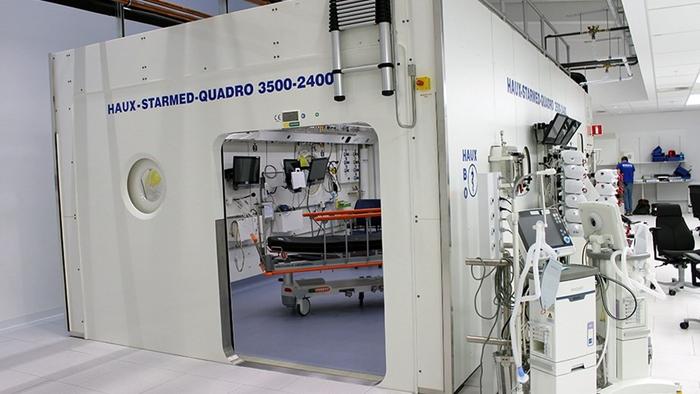Hyperbaric Oxygen Therapy Offers Lasting Relief for Late Radiation-Induced Injuries in Cancer Survivors
In a groundbreaking study emerging from the University of Gothenburg, researchers have demonstrated that hyperbaric oxygen therapy (HBOT) delivers sustained relief for patients suffering from chronic, late-onset side effects following radiation therapy in the lower abdominal region. This treatment, conducted in pressurized chambers, has shown remarkable results in alleviating debilitating symptoms such as urinary incontinence, bleeding, and intense pelvic pain—even maintaining these benefits five years post-treatment. This revelation points to a promising future in managing radiation-induced tissue damage, significantly enhancing the quality of life for cancer survivors.
Radiation remains a cornerstone in the fight against various cancers, especially those located in the prostate, colon, cervix, and ovaries. While its curative role is well-established, one of its persistent challenges is damage to surrounding healthy tissues, causing severe side effects in approximately 5 to 10 percent of patients. These complications may not manifest immediately but can surface years later, evolving into chronic conditions that severely impair physical functioning and social engagement.
The symptoms associated with radiation-induced injuries to the pelvic region can be physically agonizing and emotionally taxing. Patients often endure continual urinary leakage, painful bleeding episodes, and refractory abdominal distress. These symptoms can gravely restrict daily activities, undermine independence, and diminish overall well-being. Historically, treatment avenues for these conditions have been limited and frequently inadequate in providing long-term respite.
Hyperbaric oxygen therapy works by delivering pure oxygen at elevated atmospheric pressures inside specialized chambers. The procedure fundamentally enhances oxygen delivery to hypoxic tissues, which results in a cascade of beneficial biological effects. Elevated oxygen levels stimulate angiogenesis—the formation of new blood vessels—and aid in resolving chronic inflammation, a key driver of persistent radiation injuries. This biological environment fosters tissue regeneration and repair, effectively reversing damage that was once considered irreversible.
In the study led by senior anesthesiologist and researcher Nicklas Oscarsson, 70 adult patients with severe radiation-induced cystitis symptoms were enrolled and treated across five prominent Nordic university hospitals. Over a period involving 30 to 40 daily sessions totaling 90 minutes each, patients underwent HBOT at pressures equivalent to approximately 14 meters underwater. The control cohort, receiving conventional care comprising medications and physiotherapy, served as a benchmark for evaluating treatment efficacy.
Results were striking. Patients subjected to HBOT showed significant improvement in symptoms such as continuous bleeding, urinary incontinence, and chronic pain, outperforming the control group. Most importantly, when reassessed five years later, these benefits persisted with minimal decline. This long-term follow-up is pivotal, establishing that HBOT not only offers symptomatic relief but can potentially induce lasting healing of late radiation tissue injuries.
From a mechanistic standpoint, exposure to increased oxygen tension triggers cellular responses that enhance tissue oxygenation and reduce fibrotic blockades—common pathological hallmarks of radiation damage. The stimulation of endothelial cell proliferation and suppression of proinflammatory cytokines mitigate ongoing tissue degradation, fostering the restoration of normal pelvic tissue architecture. These detailed biological underpinnings underscore why HBOT could revolutionize management protocols for radiation side effects.
Clinically, this data emboldens physicians to advocate for HBOT more aggressively. Currently, many eligible patients with severe radiation sequelae are not routinely referred for this intervention, reflecting a gap in awareness and interdisciplinary communication. With established hyperbaric facilities already available in many healthcare systems, greater dissemination of knowledge among oncologists, urologists, and primary care providers could expand patient access dramatically, improving outcomes across the board.
Moreover, the implications of this research extend beyond symptom palliation. Severe adverse effects from radiation therapy often necessitate limiting the radiation dose, potentially compromising cancer control. The availability of a safe, effective treatment to mitigate these late effects may permit clinicians to escalate therapeutic radiation doses, targeting tumors more aggressively and increasing cure rates without sacrificing patient quality of life.
The research team has identified an important avenue for further investigation: whether initiating HBOT earlier in the course of radiation treatment or immediately post-therapy can prevent the development of chronic complications altogether. Such prophylactic strategies, if successful, could transform radiation oncology by minimizing the collateral damage that currently hinders optimal therapeutic dosing.
This multinational study included five leading universities: Rigshospitalet (Denmark), Turku (Finland), Haukeland (Norway), Karolinska (Sweden), and Sahlgrenska University Hospital (Sweden), reflecting robust collaboration across the Nordic region. The longitudinal nature and randomized controlled trial design add considerable strength to the findings, which have been published in The Lancet eClinicalMedicine journal.
Patients previously burdened by unrelenting discomfort and lifestyle restrictions can now envision a return to normalcy. The difference is profound—from urgent, debilitating symptoms to restored continence and functional independence over years following HBOT. This study not only advances scientific understanding but importantly, shines a beacon of hope for thousands of cancer survivors worldwide grappling with late radiation toxicities.
As the medical community embraces these findings, the focus must turn to educating healthcare providers and patients about the therapeutic potential of hyperbaric oxygen therapy. Increased referrals and wider adoption could soon alter the standard of care for managing radiation-induced damage, transforming chronic pain and dysfunction into manageable or even reversible conditions.
In sum, hyperbaric oxygen therapy represents a paradigm shift in treating late radiation-induced pelvic injuries, merging sophisticated biological insight with pragmatic clinical application. This approach exemplifies how targeted oxygen delivery can harness the body’s intrinsic healing capacity, offering durable relief and renewed function where options were once limited. As ongoing trials probe preventive use and broader indications, HBOT may well emerge as a cornerstone in comprehensive cancer survivorship care.
—
Subject of Research: People
Article Title: Radiation-induced cystitis treated with hyperbaric oxygen therapy (RICH-ART): long-term follow-up of a randomised controlled, phase 2-3 trial
News Publication Date: 19-Apr-2025
Web References: http://dx.doi.org/10.1016/j.eclinm.2025.103214
Image Credits: Photo: Anders Kjellberg
Keywords: Hyperbaric oxygen therapy, radiation-induced cystitis, late radiation injuries, cancer treatment side effects, tissue regeneration, angiogenesis, chronic inflammation, pelvic radiation toxicity, randomized controlled trial, long-term follow-up




